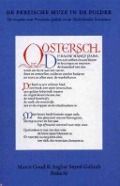The great ‘Umar Khayyám. A global reception of the Rubáiyát. A.A. Seyed-Gohrab (ed.). Leiden, Leiden University Press, 2012. 267 p. (Iranian Series). ISBN: 9789087281571.
Papers gepresenteerd tijdens de tweedaagse conferentie ‘The Legacy of Omar Khayyam’, Leiden, juli 2009.
Abstract
The Rubáiyát by ‘Umar Khayyám (1048-1131) is used in contemporary Iran as a resistance literature, symbolizing the secularist voice in cultural debates. While Islamic fundamentalists criticize Khayyám as an atheist and materialist philosopher who questions God’s creation and the promise of reward or punishment in the hereafter, secularist intellectuals see in him an example of a scientist who scrutinizes the mysteries of the world. Others see a spiritual master, a Sufi, who guides people to the truth. This volume collects eighteen essays on the history of the reception of ‘Umar Khayyám in various literary traditions, exploring how his philosophy of doubt, carpe diem, hedonism, and in vino veritas has inspired generations of poets, novelists, painters, musicians, calligraphers and film-makers.
Inhoud
Acknowledgements, p. 9
– A.A. Seyed-Gohrab – Khayyám’s Universal Appeal: Man, Wine, and the Hereafter in the Quatrains, p. 11
– M. Aminrazavi – Reading the Rubá’iyyát as “Resistance Literature”, p. 39
– A.H. Morton – Some ‘Umarian Quatrains from the Lifetime of ‘Umar Khayyām, p. 55
– M. Bagheri – Between Tavern and Madrasa: ‘Umar Khayyám the Scientist, p. 67
– M. Alsulami – The Arab Umar Khayy”am, p. 73
– Jan Just Witkam – Ahmad Rámí’s Arabic translation of the Quatrains of ‘Umar Khayyám, p. 85
– S. Sötemann – Quatrains of ‘Umar Khayyám in Turkish and Turkish Quatrains, p. 97
– J.T.P. de Bruijn – Other Persian Quatrains in Holland: the Roseraie du Savoir of Husayn-i Ázád, p. 105
– M. Goud – Khayyám’s Impact on Modern Dutch Literature, p. 115
– J.D.F. van Halsema – Bitter Certainty: J.H. Leopold on ‘Umar Khayyám, p. 129
– J. Biegstraaten – How ‘Umar Khayyám Inspired Dutch Visual Artists, p. 135
– A.A. Seyed-Gohrab – Khayyám’s Universal Appeal: Man, Wine, and the Hereafter in the Quatrains, p. 11
– M. Aminrazavi – Reading the Rubá’iyyát as “Resistance Literature”, p. 39
– A.H. Morton – Some ‘Umarian Quatrains from the Lifetime of ‘Umar Khayyām, p. 55
– M. Bagheri – Between Tavern and Madrasa: ‘Umar Khayyám the Scientist, p. 67
– M. Alsulami – The Arab Umar Khayy”am, p. 73
– Jan Just Witkam – Ahmad Rámí’s Arabic translation of the Quatrains of ‘Umar Khayyám, p. 85
– S. Sötemann – Quatrains of ‘Umar Khayyám in Turkish and Turkish Quatrains, p. 97
– J.T.P. de Bruijn – Other Persian Quatrains in Holland: the Roseraie du Savoir of Husayn-i Ázád, p. 105
– M. Goud – Khayyám’s Impact on Modern Dutch Literature, p. 115
– J.D.F. van Halsema – Bitter Certainty: J.H. Leopold on ‘Umar Khayyám, p. 129
– J. Biegstraaten – How ‘Umar Khayyám Inspired Dutch Visual Artists, p. 135

